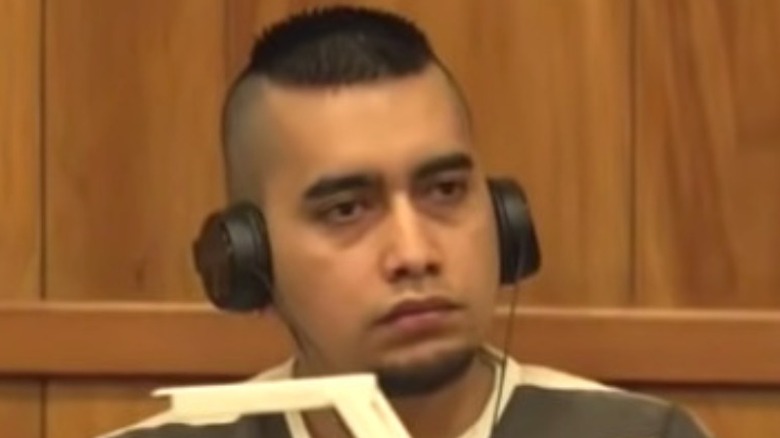The Tragic Murder Of Mollie Tibbetts Explained
On the evening of July 18, 2018, University of Iowa student Mollie Tibbetts was on her nightly run through Brooklyn, Iowa, when she seemingly vanished without a trace. As reported by NPR, her body was found just over one month later and it was ultimately determined she was stabbed to death. The investigation into her death, the arrest of an undocumented immigrant, and the man's confession drew outrage not only for the heinous nature of the crime but also how politicized the case ultimately became.
On the evening she vanished, Tibbetts was staying at the home of her boyfriend, Dalton Jack. As reported by People, Jack was out of town working a construction job, and Tibbetts agreed to take care of his dogs while he was gone. According to Jack, Tibbetts routinely went for a run in the evening, as the sun was setting and it was cooler. He also confirmed that she knew the area well, and was not likely to have gotten lost. Authorities later confirmed Tibbetts left her identification card and keys at Jack's house when she left for her run. However, she had taken her phone.
Jack received a text message from Tibbetts at approximately 7:00 p.m. A Snapchat session was also initiated to Jack from Tibbetts phone at approximately 10:00 p.m. However, it is unclear who opened the app, as no messages were ever sent. People reports Jack realized something was wrong when he received a call from one of Tibbetts' coworkers the following day.
Cristhian Bahena Rivera was charged in Mollie Tibbetts' death
According to the coworker, Mollie Tibbetts did not show up for work or call in to report that she was taking the day off -– which was unusual for her. People reports Jack checked his phone and realized Tibbetts had not responded to any of his text messages. He then began contacting his girlfriend's family and friends, who had not heard from her since the previous day.
As reported by The Gazette, Tibbetts' mother filed a formal missing person report on July 19, 2018. Although her friends and family had already begun conducting a search, they were joined by the Iowa Division of Criminal Investigation on July 20 and the Federal Bureau of Investigation on July 23.
Although it took over one month, The Gazette reports Mollie Tibbetts' body was eventually discovered in a cornfield in a rural part of Guernsey, Iowa. Later that same day, authorities confirmed they were led to the remains by 24-year-old Cristhian Bahena Rivera, who was the primary suspect in her disappearance.
Authorities identified Rivera as a suspect after viewing surveillance footage from the area where Tibbetts had been running on the evening she disappeared. As reported by the Des Moines Register, the footage revealed a black Chevy Malibu, which was later connected to Rivera, was seen passing through the neighborhood numerous times around the time Tibbetts went missing. When questioned, Rivera provided authorities with a detailed confession to Tibbetts' abduction and eventual murder.
Rivera said he got mad when Tibbetts tried to fend him off
Des Moines Register reports Rivera said he initially spotted Tibbetts while she was running in Brooklyn. He drove around and passed her several times before parking his car along her route. He then exited the vehicle and began following her on foot as she ran toward Poweshiek County.
When she realized she was being followed, Rivera said Tibbetts threatened to call the police. However, he took her phone before she could complete the call. The U.S. Sun reports, Rivera "became very angry" when Tibbetts "tried to slap him and was screaming at him."
Although he remembers grabbing her somewhere on the 1900 block of 385th Avenue, Des Moines Register reports he said he claims he cannot remember what happened next. Rivera said he did remember driving in a cornfield. He said he later realized Tibbetts was likely in his trunk. Rivera then opened the trunk, removed the young woman, and dumped her approximately 65 feet from where he parked.
Rivera said he did not remember when he actually killed Tibbetts, and authorities never confirmed whether she was murdered before or after she was placed in the trunk. The Gazette reports a coroner later confirmed Tibbetts' death was caused by sharp force trauma to the head.
As reported by Oxygen True Crime, Cristhian Bahena Rivera was ultimately charged with first-degree murder. The U.S. Sun reports Rivera's status as an undocumented immigrant was announced, and became a point of contention, shortly after his arrest.
Mollie Tibbetts' murder sparked political controversy
The U.S. Sun reports Cristhian Bahena Rivera left Mexico and entered the United States unlawfully as a teenager and remained in the United States, where he was employed as a farmworker. In the weeks and months following his arrest, Rivera's status as an undocumented immigrant and an accused killer became part of a larger conversation about the United States' immigration policies.
In a video Twitter post, then-President Donald Trump used the case as an example of why he believed it was necessary to tighten security at the border and revise immigration laws. As reported by New York Times, Trump said, "A person came in from Mexico and illegally killed (Mollie Tibbetts). We need the wall, we need our immigration laws changed, we need our border laws changed."
New York Times reports the case highlighted the dispute between Democrats who accused Republicans of "callous exploitation and fear-mongering," and Republicans who accused Democrats of "trumping public safety" in favor of "political correctness." Throughout Rivera's trial, political figures exchanged harsh comments about Rivera's status and current and proposed immigration law. However, the heart of the case remained the fact that a young college student was abducted and brutally killed.
During jury selection, The U.S. Sun reports Rivera's attorney, Chad Frese reminded the prospective jurors that despite his undocumented status, Rivera was protected by the same rights as a United States citizen. Frese also said that Rivera's difficulty in speaking English should not be held against him.
Rivera was found guilty of first-degree murder and sentenced to life in prison
After just over seven hours of deliberation, a jury found Cristhian Bahena Rivera guilty of first-degree murder in the death of Mollie Tibbetts. He was subsequently sentenced to life without the possibility of parole.
Prior to his sentencing, Des Moines Register reports Rivera's attorneys filed a motion for a new trial, amid claims that Rivera was coerced into abducting and killing Tibbetts by two unidentified masked men. They also argued that the masked men, and her abduction, may have been connected to the abductions of another young woman and an 11-year-old child who were both taken from the same region at around the same time. Evidence was also presented that another man, named Gavin Jones, had confessed to two people that he was Tibbetts' killer. Although Judge Joel Yates agreed to hear the new evidence, he ultimately determined there was not enough evidence for a new trial.




